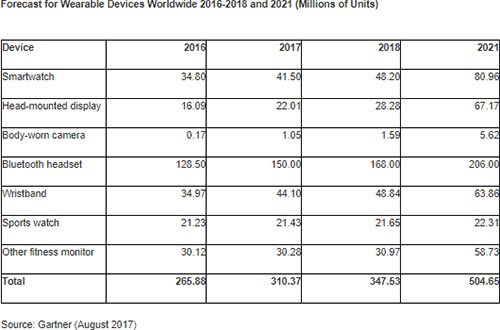The market for wearable devices will generate $30.5 billion in revenue when 2017 comes to a close, nearly a third of which will come from sales of smartwatches ($9.3 billion), according to a forecast from Gartner. In total, vendors are expected to sell 41.5 million smartwatches in 2017.
And there’s nowhere to go but up.
“Smartwatches are on pace to achieve the greatest revenue potential among all wearables through 2021, reaching $17.4 billion,” said Gartner research director Angela McIntyre in a statement. “The overall [average selling price] of the smartwatch category will drop from $223.25 in 2017 to $214.99 in 2021 as higher volumes lead to slight reductions in manufacturing and component costs, but strong brands such as Apple and Fossil will keep pricing consistent with price bands of traditional watches.”
Expect more of today’s luxury watchmakers to get in on the action. Nearly a quarter of the nearly 81 million smartwatches to be sold will come from traditional and luxury brands, predicted the analyst firm. “Luxury and fashion watch brands will offer smartwatches in an attempt to attract younger customers,” added McIntyre.
There will also be some room for startups and while-label brands, Gartner noted. Companies like Archos, Cogito, Martian and Quanta are poised to generate five percent of smartwatch sales in 2021.
In total, vendors are expected to sell 310.4 million wearables this year, a 16.7-percent increase compared to 2016. By 2021, Gartner expects that figure to exceed 504 million. Smartwatches, head-mounted displays, sports watches, fitness trackers, body cameras and Bluetooth headsets all fall under Gartner’s definition of a wearable device.
In terms of Bluetooth headsets, the gradual disappearance of the 3.5mm headphone jack will also help drive demand. By 2021, McIntyre predicts that nearly all premium smartphones will no longer feature the venerable connector, helping to push sales of Bluetooth headsets to 206 million units during the same year, up from an estimated 150 million in 2017.
For now, it’s up to video gamers to fuel the nascent market for augmented- and virtual-reality headsets, but that will change as more businesses and mainstream consumers begin to discover the appeal of virtual worlds and how head-mounted displays can promote productivity.
This year, 22 million head-mounted displays will crown buyers’ craniums. By 2021, more than 67 million units will be bought, as more workers use them to inspect equipment, facilitate repairs and design tomorrow’s devices, among countless other use cases.
Pedro Hernandez is a contributing editor at Datamation. Follow him on Twitter @ecoINSITE.



